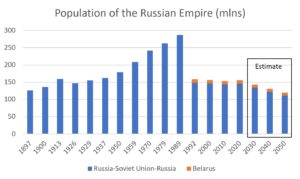Russia is a multi-ethnic empire. The “traditional” Western empires such as Britain have well-known histories involving their often-distant possessions (though their home territories also featured a variety of ethnic groups such as the Scots, Welsh, Irish, etc.) In contrast, Russia is a solely contiguous, but very large amalgamation of numerous ethnicities. In some cases, the ethnicities have distinct geographies, but often the populations are just jumbled amidst the overall polity. Some of those ethnicities within Russia have been distinct for centuries, some were a product of 19th century nationalism, and some (ironically) were created nearly from scratch in the early days of the Soviet Union.
This nearly unique situation creates specific geo-political dynamics, particularly in regard using population as a measure of an empire’s health. While the population of a single political entity may not be the best measure of its overall health, it is certainly an important metric.
And from that perspective, Russia’s outlook appears to be bleak. Consider the population trend of the Russian Empire. While the figures are approximate, the direction is not. Russia’s first modern census in 1897 put the population at 126 million, around 8% of the world’s then total. At the time, the empire was enjoying great growth. By the eve of World War I, the Tsar’s population was 159 million, nearly 9% of the worldwide count. That would constitute Russia’s peak share of global population.
The early decades of the Soviet Union–which inherited essentially almost all of the former Russian Empire–were not conducive either to population growth or to census taking, but genuine expansion resumed after World War II. The final census prior to the collapse of the Soviet Union tallied 287 million souls. While larger in absolute terms, the Soviet Union was now just 5.3% of the world population at the time.
In 1991, as the Soviet Union became Russia, it lost almost half of its population, to around 148 million. The population of the Russian Republic–a smaller empire, but a multi-ethnic polity all the same–has declined slightly over the past 30 years–even as the world’s population has continued to rise. Russia now holds less than 2% of the world’s citizens. And the outlook is for further diminishment. Due to low birth rates and high death rates, only partially offset by labor in-migration from Central Asia, Russia’s population is forecast to fall during the next several decades, perhaps hitting 111 million by 2050.
So what? Now consider Russia invading Ukraine. Many reasons have been posited, but here is another one: When Ukraine split from Russia in 1991, it took with it a population of around 50 million. After three very difficult decades, Ukraine still had a population of 40 million, almost entirely “Slavs” (ethnic Ukrainians and Russians.) Whatever the official explanations for the invasion, bringing those “souls” back into the fold had to appeal to Russia’s leadership.
Russia’s dramatic gambit to stave off population decline has failed spectacularly. And it has worsened Russia’s demographic crisis. Another 100,000 Russians have been killed in short order and approximately 1 million more have fled the country, at least temporarily. As a result of the invasion and the resulting chaos within Russia, birthrates are likely to suffer even more.
For the future, keep an eye on Kaliningrad, the former Königsberg. It is a geographical outlier that may be difficult for Russia to maintain. And as I have suggested repeatedly in prior commentaries, I believe Russia will struggle to control the already sparsely populated Russian Far East in the decades ahead. Some ethnic groups within Russia–particularly those with their own administrative entities and on the borders of the Russian state–may also seek a way out.
I’ve updated the chart to include Belarus’s 9 mln people as part of the current Russian Republic. Like Ukraine, Belarus became independent of Russia in 1991. Unlike Ukraine, Belarus has stayed close and gotten even closer in recent years. As things stand now, Belarus is a de facto possession of the Russia. Adding Belarus’s then population of around 10 million back to Russia’s softens the blow of 1991 a bit, but it creates the prospect of an additional “breakaway” in the future, with the loss of another 9 million, if and when the regime in Minsk fails.
The population counts of the leading Western Europe powers are flat. The same is true of the United States. Japan has an ominous trajectory. Even China has stopped growing. But the decline of Russia as a population center is in an entirely different category.
All hegemons–whether they are empires or not–eventually fail. It is a matter of whether that failure is slow, gradual and peaceful, or fast, steep and chaotic. Through the prism of population, Russia’s invasion of Ukraine suggests the latter course.
